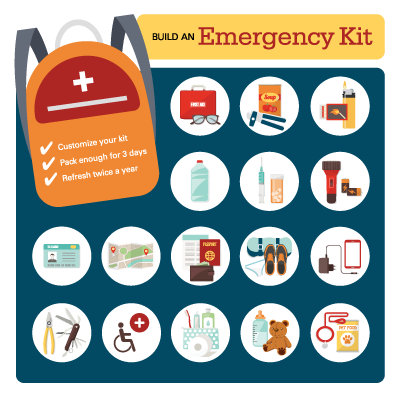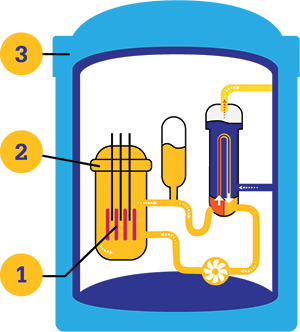How can we help you?


It is important to know which types of disasters could affect your area. Your Emergency Plan will contain emergency contacts, medical information, your protective action zone, evacuation and sheltering information, and more.
Your Emergency Kit should have supplies to last at least three days for each family member. Keep it in an easy-to-carry bag, such as a backpack, duffel bag, or suitcase.
Kit items include:
Persons with access and functional needs who may need evacuation assistance—Make a Plan. Contact your locality to learn about options and how to sign-up for services. Locality contact information is provided under More Information below.

Not all shelters and hotels accept pets. Plan ahead to stay with family, friends, or at pet-friendly locations if you need to evacuate your home. If a hotel has a no-pets policy, ask if they can waive the policy during an emergency. Don’t hesitate to leave your home in an emergency because you don’t want to leave your pet(s) behind.
Kit items to include:
The following are pet-friendly hotel resources: bringfido.com, dogfriendly.com, petswelcome.com, and tripswithpets.com.

| Radio | Tv Station |
|---|---|
Richmond Hampton Roads Eastern Virginia Gloucester |
Richmond Hampton Roads York / Fort Eustis |
The 10-mile area around Surry Power Station is divided into 30 zones, called Protective Action Zones (PAZ). Knowing your PAZ will let you know if your zone is affected by the emergency and what action(s) to take to keep you safe.
Listen carefully to instructions specific to your zone. Not all PAZs may be affected by the emergency or need to evacuate.
If your PAZ is instructed to evacuate, listen for instructions to report to your assigned Evacuation Assembly Center (EAC). EACs offer contamination monitoring, and if recommended, potassium iodide (KI). Learn more about Potassium Iodide (KI) below.
Service animals and pets are the only animals allowed in the EAC.
A service animal is any guide dog, signal dog, or other animal individually trained to provide assistance to an individual with a disability including, but not limited to, guiding individuals with impaired vision, alerting individuals with impaired hearing to intruders or sounds, providing minimal protection or rescue work, pulling a wheelchair, or fetching dropped items.
A pet is a domesticated animal, such as a dog, bird, rabbit, rodent, or turtle that is traditionally kept in the home for pleasure rather than for commercial purposes, can travel in commercial carriers and be housed in temporary facilities. Household pets do not include reptiles (except turtles), amphibians, fish, insects/arachnids, farm animals (including horses), and animals kept for racing purposes.
Warwick High School
51 Copeland Lane
Newport News, VA 23601
Hines Middle School
561 McLawhorne Drive
Newport News, VA 23601
Gildersleeve Middle School
1 Minton Drive
Newport News, VA 23606
Warhill High School
4615 Opportunity Way
Williamsburg, VA 23188
Smithfield Middle School
14175 Turner Drive
Smithfield, VA 23430
Warhill High School
4615 Opportunity Way
Williamsburg, VA 23188
L.P. Jackson Middle School
4255 New Design Road
Dendron, VA 23839
Grafton School Complex
405 Grafton Drive
Yorktown, VA 23692
Tabb High School
4431 Big Bethel Road
Yorktown, VA 23693
New Kent County High School
7365 Egypt Road
New Kent, VA 23124
If Your Protective Action Zone is Told to Evacuate:
If Your Protective Action Zone is Told to Shelter-in-Place:
Not every radiological emergency will result in the release of radioactive material. Potassium iodide (or KI), non-radioactive form of iodine, may be recommended as an additional protective measure to help protect your thyroid gland in the event of a radiological emergency. KI tablets will be provided by emergency officials and handed out at your assigned EAC.
For more information on potassium iodide, visit the Virginia Department of Health’s Potassium Iodide webpage.
Livestock and poultry owners are responsible for the care and wellbeing of their animals. Livestock and poultry owners, farmers, and producers should develop and maintain an emergency plan specific to their needs to use in the case of an evacuation.
Nuclear plant emergencies may impact livestock, food, and agricultural products. Protective actions for livestock and agricultural products will be issued by appropriate state and local officials. These actions may include:
For more information about disaster planning for livestock and agriculture, contact your local cooperative extension agent or emergency management office and download the U.S Department of Agriculture’s (USDA) Livestock Preparedness Fact Sheet.
Nuclear power plants are designed, engineered, and operated to adhere to stringent safety and security regulations and practices. Multiple layers of safety systems and structures protect the plant and community from an emergency:
There are three fission product barriers (also referred to as protective barriers) that prevent the release of radioactive material into the environment: (1) fuel cladding, (2) reactor vessel and cooling system, and (3) containment.
The Nuclear Regulatory Commission (NRC) defines four emergency classifications that could occur at a nuclear power station. Dominion Energy would contact federal, state, and local authorities in each of the following situations:

For additional emergency preparedness and response information specific to your area, visit your local emergency management or public safety agency website, or contact your locality directly.
If you are an individual with access and functional needs that requires evacuation assistance in an emergency, complete your locality’s registry form or contact the number provided by your locality to see what services are available:
24-hour: 757-247-2500
To receive local alerts and information from the City of Newport News, subscribe to NNAlert.
24-hour: 757-890-3621
Individuals with access and functional needs needing evacuation assistance, contact the City’s Human Services Department at 757-220-6161.
To receive alerts and information from the City of Williamsburg, subscribe to Williamsburg Alerts.
Office: 757-365-6308 | 24-hour: 757-357-2151
Individuals with access and functional needs needing evacuation assistance, contact 757-365-6308.
To receive local alerts and information from Isle of Wight County, subscribe to IWAlert.
24-hour: 757-890-3621
Individuals with access and functional needs needing evacuation assistance, go to the county’s Department of Social Services and Housing and complete the Access Functional Needs Registry Form, or contact 757-259-3100.
To receive local alerts and information from James City County, subscribe to JCC Alert.
24-hour: 757-294-5264
Individuals with access and functional needs needing evacuation assistance, contact the Department of Social Services at 757-294-5240.
To receive local alerts and information from Surry County, subscribe to Surry Alert Center.
24-hour: 757-890-3621
Individuals with access and functional needs needing evacuation assistance, complete the Heads Up Form, or contact 757-890-3621.
To receive local alerts and information from York County, subscribe to RAVE Alert.
Office: 804-750-8845 (or toll free at 800-468-8892)
Visit the VDEM website for emergency preparedness and response information for all types of hazards.
Provides radiological health and other emergency preparedness and response information.
Call VA 2-1-1 for information on all kinds of topics, including school closures, evacuation assembly center, emergency preparedness and other emergency planning topics.
Call Dominion Energy toll-free at 833-380-6404 for more information about nuclear power station operations and preparedness, or to request a hard copy of this information mailed to you at no cost.